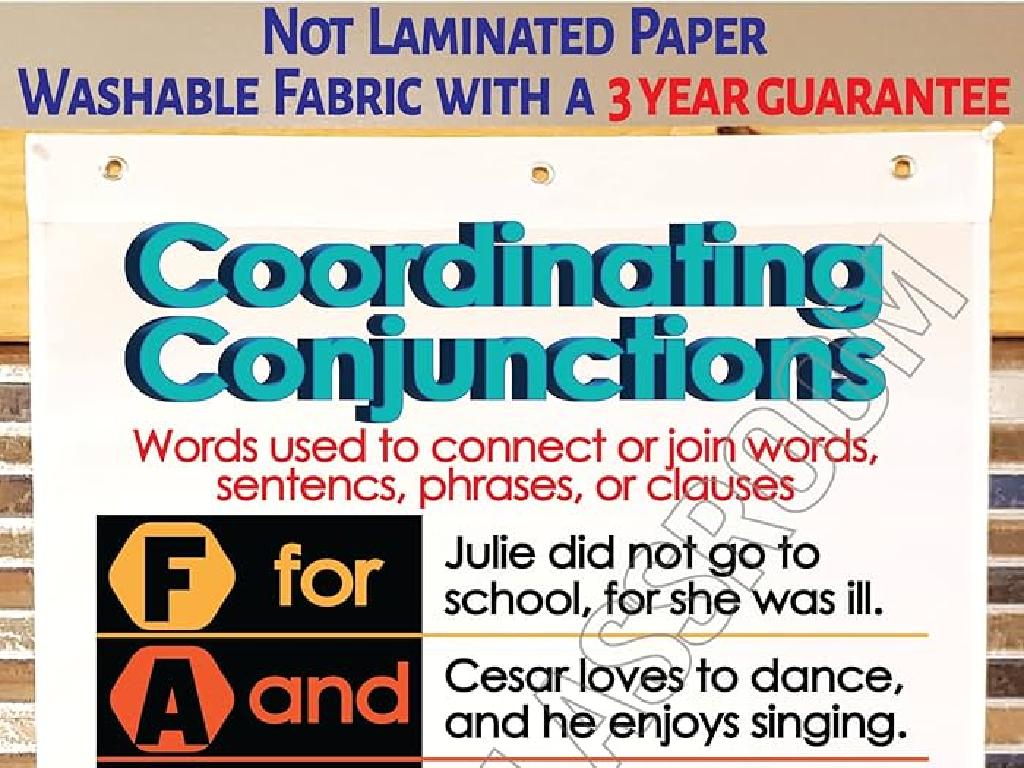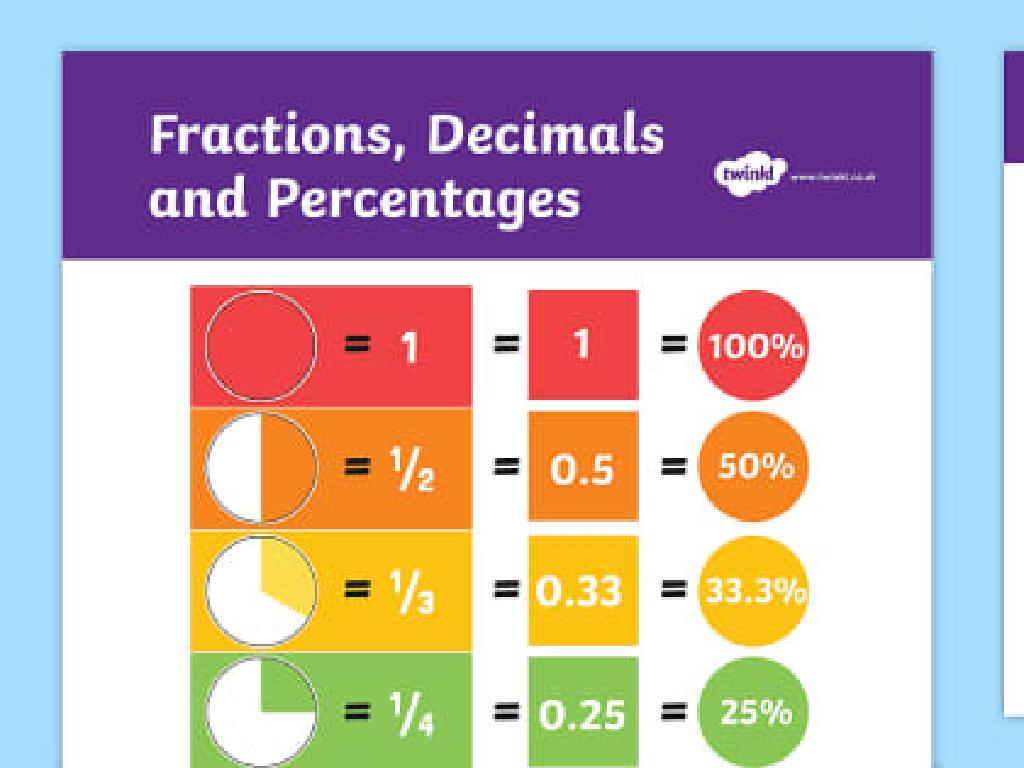Understanding Area Of A Triangle
Subject: Math
Grade: Sixth grade
Topic: Perimeter And Area
Please LOG IN to download the presentation. Access is available to registered users only.
View More Content
Understanding the Area of a Triangle
– Recap: Perimeter of shapes
– Perimeter is the total distance around a shape.
– Introduction to Area
– Area measures the space inside a 2D shape.
– Area of a Triangle
– For triangles, area is found differently than rectangles.
– Formula: 1/2 x base x height
– This formula helps us calculate the triangle’s area.
|
Begin the lesson by recapping the concept of perimeter as the total distance around the edge of a shape, which they should be familiar with. Then, introduce the concept of area as a measure of the space contained within a two-dimensional shape. Explain that the area of a triangle is unique and requires its own formula. Teach them the formula for the area of a triangle, which is one-half times the base times the height. Use visual aids to show how the base and height are determined and how this formula is derived from the area of a rectangle. Provide examples of different triangles and demonstrate how to apply the formula. Encourage students to ask questions and to practice with simple examples.
Understanding the Area of a Triangle
– Area: space inside a 2D shape
– Measured in square units
– e.g., square inches (in²), square feet (ft²)
– Importance of area knowledge
– Used in real life for flooring, painting walls
– Area of a triangle formula
– (base x height) / 2 gives area in square units
|
The concept of area is fundamental in mathematics as it represents the size of a two-dimensional space. It’s measured in square units, which could be inches, feet, or meters, depending on the context. Understanding area is crucial for practical applications like calculating the amount of material needed for construction or crafts. For a triangle, the area can be found using the formula (base x height) / 2. This slide will help students grasp the basic concept of area and its real-world significance, setting the stage for learning how to calculate the area of various shapes, starting with triangles.
Triangles Everywhere!
– Identify triangles in surroundings
– Learn triangle types: Equilateral, Isosceles, Scalene
– Equilateral: 3 equal sides, Isosceles: 2 equal sides, Scalene: no equal sides
– Classroom activity: Find & draw triangles
– Look around, spot different triangles, draw them on paper
– Discuss triangle observations
– Share the triangles found and discuss their types
|
This slide is aimed at helping students recognize triangles in their environment and understand the different types of triangles. Start by asking students to look around and identify objects that are triangular. Explain the characteristics of equilateral, isosceles, and scalene triangles. For the activity, have students walk around the classroom to find triangles and draw them on paper. Afterward, facilitate a discussion where students share their drawings and describe the types of triangles they found. This will reinforce their understanding of triangle types and encourage observational skills. Provide examples like a slice of pizza (scalene), a yield traffic sign (equilateral), and the classroom’s A-frame roof (isosceles) if applicable.
Understanding the Area of a Triangle
– Area of a triangle formula
– Area = 1/2 x base x height
– Labeling triangle parts
– Base is the bottom side, height is perpendicular to base
– Practice with examples
– Example: Find area with base 10 cm, height 5 cm
|
This slide introduces the formula for calculating the area of a triangle, which is a fundamental concept in geometry. The formula is Area = 1/2 x base x height. It’s crucial to ensure that students can identify the base and the height of a triangle, as these are the key components needed to use the formula. The base is any side of the triangle, and the height is the perpendicular line from the base to the opposite vertex. Use visual aids to help students label these parts on various triangles. Provide practice examples for students to apply the formula, such as finding the area of a triangle with a base of 10 cm and a height of 5 cm. Encourage students to solve it as a class activity and discuss any questions they may have about the process.
Calculating the Area of a Triangle
– Area formula: 1/2 x base x height
– Example: base 8 units, height 5 units
– For our triangle, area = 1/2 x 8 x 5
– Step-by-step calculation
– Multiply 1/2 by base (8) and then by height (5)
– Practice with various measurements
– Try finding area for triangles with different base and height values
|
Introduce the formula for calculating the area of a triangle as half the product of its base and height. Use a specific example with a base of 8 units and a height of 5 units to demonstrate the calculation process. Walk students through the multiplication step by step, emphasizing the importance of each part of the formula. After the example, provide practice problems with different measurements to solidify their understanding. Encourage students to work through these problems and be ready to discuss their solutions in the next class.
Real-World Application: Area of a Triangle
– Importance in architecture
Used to design roofs, trusses, and bridges.
– Influence on art designs
Helps in creating patterns and tessellations.
– Essential for engineering
Crucial in structural analysis and design.
– Discuss other applications
|
Understanding the area of a triangle is not just a mathematical exercise; it has practical applications in various fields. Architects use triangle calculations when designing structures such as roofs and bridges, ensuring stability and aesthetic appeal. Artists may apply knowledge of triangles in creating patterns and tessellations that are pleasing to the eye. Engineers rely on these calculations for structural analysis, which is essential in designing safe buildings and other constructions. Encourage students to think creatively and discuss other areas where knowing how to calculate the area of a triangle might be useful, such as in planning gardens or any other field that involves spatial planning.
Class Activity: Triangle Area Hunt
– Find classroom triangle-shaped objects
– Measure sides and heights of triangles
– Calculate the area of each triangle
– Use the formula: Area = 1/2 * base * height
– Share your findings with the class
|
This interactive class activity is designed to help students apply their knowledge of calculating the area of a triangle in a fun and engaging way. Students will search for objects in the classroom that are shaped like triangles, such as flags, signs, or book covers. They will then use rulers to measure the base and height of these triangles. After measurements, students will calculate the area using the formula (Area = 1/2 * base * height). Encourage students to work in pairs or small groups to foster collaboration. Prepare to facilitate by having rulers and calculators available. Possible variations of the activity could include using different units of measurement, finding the area of composite shapes that include triangles, or even creating their own triangle objects to measure and calculate. Conclude the activity with a discussion about where triangles are found in everyday objects and the importance of understanding their properties.
Review and Reflect: Area of a Triangle
– Recap: Area of a triangle formula
Area = 1/2 * base * height
– Importance of triangle area knowledge
Useful in real-life for planning spaces and construction
– Quick Quiz to test understanding
– Reflect on today’s learning
Think about how this applies to real-world problems
|
This slide aims to consolidate the day’s learning by reviewing the formula for calculating the area of a triangle. Emphasize the practical applications of this knowledge, such as in architecture, engineering, and even simple tasks like home decoration. The Quick Quiz should include a few problems that require students to apply the formula in different scenarios, reinforcing their understanding. Encourage students to reflect on how the lesson’s content can be useful in their daily lives and in future mathematical concepts. This reflection helps students see the value in what they’ve learned and how it connects to the world around them.
Homework: Exploring Triangle Areas
– Complete the area worksheet
– Create a unique triangle
– Draw a triangle with any dimensions you like
– Calculate your triangle’s area
– Use the formula: Area = 1/2 * base * height
– Discuss your findings next class
|
This homework assignment is designed to reinforce the concept of calculating the area of a triangle. Students are provided with a worksheet containing various triangles for which they must find the area using the formula (Area = 1/2 * base * height). Additionally, they are tasked with creating their own triangle, further personalizing the learning experience. This encourages creativity and application of the formula in a new context. In the next class, students will discuss their methods and results, promoting peer learning and confidence in their mathematical abilities. For the teacher: Prepare to facilitate the discussion by asking students about the different triangles they created and how they approached the calculation. Offer 4-5 different types of triangles on the worksheet to cater to varying levels of difficulty.






